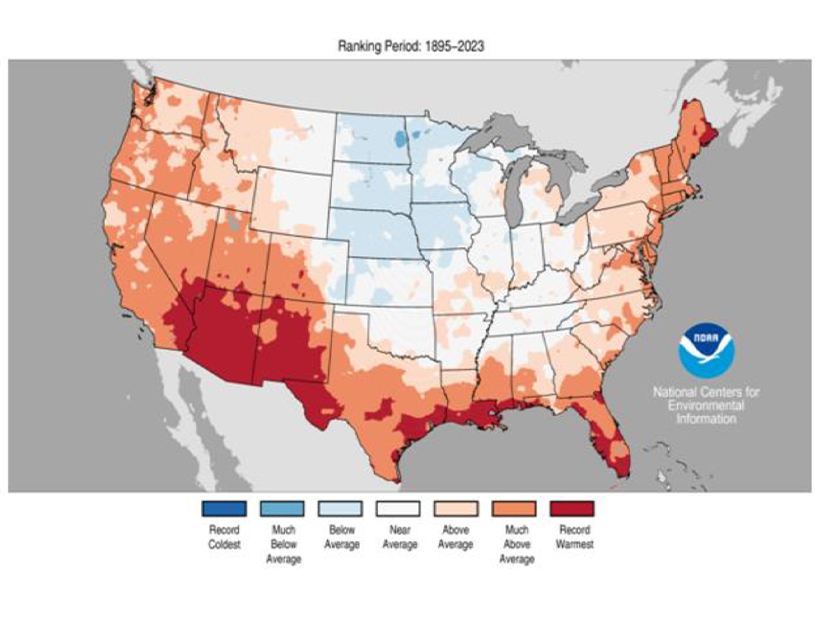CAISO’s issuance of energy emergency watches and alerts in July came under conditions that mirrored those during California’s September 2022 heatwave.
CAISO’s issuance of energy emergency watches and alerts on three days in July came under conditions that mirrored those during California’s September 2022 heatwave, officials said.
Several “challenging evenings of grid operations” led the ISO to issue a Stage 1 energy emergency alert (EEA 1) on July 20, followed by EEA watches on July 25 and 26, CAISO CEO Elliot Mainzer told the Board of Governors on Thursday.
The period was marked by high demand from a record-setting heat wave in the Southwest, Mainzer said, while demand was “high but not excessive” in California and hydro conditions in the Pacific Northwest were below average.
In the Southwest, record-breaking temperatures included an average high in Phoenix of 114.7 degrees for the month of July, compared to the previous record of 109.8 degrees in July 2020.
“In many ways, conditions were the mirror image of what we saw last September when California was on the edge with a historic heat wave, and other regions were able to supply us with large quantities of power to help maintain reliability,” Mainzer said in a report to the board.
So far, the three alerts are the only times CAISO triggered the emergency alert system this year, Mainzer said. No Flex Alerts — in which consumers are asked to voluntarily conserve energy — have been issued in 2023.
In addition to Mainzer’s report to the board, CAISO also released last week a summer market performance report for July that goes into more detail on the EEA events. A Sept. 27 meeting has been scheduled to discuss the report.
July 20: EEA 1
Energy emergency alerts range from EEA 1, which includes calls for conservation measures and demand response, to EEA 3, in which rotating blackouts may be ordered. An EEA watch is a preliminary step before CAISO declares an alert.
When an energy emergency alert or watch is issued, CAISO has access to additional resources, such as the emergency load reduction program (ELRP), in which electricity customers are paid to voluntarily reduce their demand, and the state’s Strategic Reliability Reserve.
CAISO issued an EEA 1 at 7:30 p.m. on July 20 in response to “rapidly evolving grid conditions observed during real-time operations,” according to the monthly performance report. The July 20 conditions came up relatively unexpectedly, in contrast to grid events in 2020 and 2022 that were projected far in advance, the report said.
One and two days ahead, the market seemed able to meet the projected demand for July 20, although with thinning capacity margins.
But as the system approached net load peak on July 20, “the anticipated supply did not fully materialize,” the report said.
CAISO said reasons for the decreased supply included resource outages and derates; fewer imports due to potential fire impacts; and resources not dispatched due to congestion.
At the same time, demand was high from the desert Southwest, which experienced record-breaking high temperatures this summer. As a result, net imports were reduced during the net load peak.
Another issue was that a display of resource availability overestimated the amount of resource dispatch capability available — mostly due to storage resources that were providing multiple services, CAISO said.
As a result of the EEA 1, CAISO deployed resources from the ELRP. Normal operations resumed around 8:30 p.m.
July 25 and 26: EEA Watch
Factors similar to those that occurred on July 20 led CAISO to issue an EEA watch on July 25, effective at 7:30 p.m.
The ISO said it was seeing high external demand, wildfire threats to transmission, and the loss of about 2,000 MW of California resources “due to outages between the day-ahead and real-time markets.”
During peak hours, congestion on the Path 26 transmission lines made it difficult to send supply from the northern part of the system to Southern California, where it was still hot.
Another EEA watch was issued for July 26, from 6 to 10 p.m.
The report also discussed the flexible ramping product used by the real-time market. The EEA 1 on July 20 was sparked by a ramping shortfall as solar resources went offline in the evening hours.
The ramping product doesn’t procure capacity in response to unexpected outages or loss of imports, and so it had limited success addressing emerging uncertainty issues during the July events, CAISO said.
September 2022 Heat Wave
This year’s highest peak demand so far was 43,545 MW on July 25 at 6:27 p.m., well below the record peak of 52,061 MW on Sept. 6, 2022, during last year’s California heat wave. CAISO declared an EEA 3 that day but rotating blackouts were avoided after the governor’s Office of Emergency Services sent out a text alert at 5:45 p.m. urging consumers to conserve electricity.
Within 20 minutes, demand plunged by 2,385 MW and blackouts were averted. (See CAISO Reports on Summer Heat Wave Performance.)
Overall, operational conditions this summer have been “significantly less strained” compared to last year, CAISO said.
The state has been better positioned in terms of resource adequacy because of a record snowpack and strong hydro production, along with the addition of significant amounts of generating and storage resources.
Mainzer said August was another month with “a set of interesting conditions West-wide.” CAISO expects to release a market performance report for August next month.



